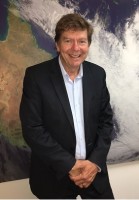Weather watcher reflects on career of storms, cyclones and bushfires
20/12/2016

The man in charge of providing weather information to New South Wales and Canberra for over a decade won't be able to leave the wind and clouds entirely alone after he retires from the Bureau of Meteorology this week.
One of Australia's leading meteorologists, Barry Hanstrum has seen major leaps forward in both forecasting technology and provision of services to the community during his 37 years with the Bureau, the past 12 of which have been spent in Sydney, primarily in the role of Regional Director.
Over that time NSW has experienced major East Coast Lows (2007, 2015 and 2016), the Sydney dust storm of 2009, state-wide floods, many devastating bushfires and the Kurnell tornado last year.
Mr Hanstrum started his forecasting career in his home state of Western Australia, inspired by the clouds he would watch in the vast skies over the wheatbelt as a curious child. As a teenager, young Barry would conduct his own weather experiments and sent a letter to the Bureau of Meteorology in Perth asking for career advice.
Mr Hanstrum said advances in technology had changed the game since those humble beginnings.
"When I was forecasting in the 1980s I couldn't have imagined we would be able to predict major weather events four to five days out, as is the case today," Mr Hanstrum said.
"Back then, if you could forecast successfully one or two days ahead you were doing well.
"We received three-hourly satellite pictures that were very coarse in resolution and stuck together with sticky tape. Now we work with high definition ten-minute images from the Himawari satellite that show the atmosphere from space in great detail and tell us almost in real time about the developments of clouds and storms.
"Another major development was the opening of the Terrey Hills weather radar in 2009. This has become a critical asset for the Sydney community to make a range of decisions, from whether to put out the washing, pour concrete on a construction site, or to see where thunderstorms are occurring."
Mr Hanstrum said he was also impressed with the way in which communications technology, including the internet, smart phones and apps, had opened up the world of meteorology to the Australian public.
“You can now receive advanced information at home, in your living room or wherever you are on your phone. Who would have imagined that back then?" Mr Hanstrum said.
But Mr Hanstrum said despite advances in technology and dissemination of weather information, nature had a way of throwing in some big surprises, such as the massive dust storm of September 2009 that blew into Sydney following a long drought in the outback of South Australia.
“I’ll never forget the eerie orange glow in the early morning sky as I went to work to answer media enquiries,” Mr Hanstrum said.
“Other particularly vivid memories are the pictures of the Pasha Bulker aground on the beach at Newcastle from the 2007 East Coast Low, the major flood in the lower Hunter Valley in April 2015 and the most recent East Coast Low in June when we saw the devastating erosion of the Sydney coastline.
"Given the population along the New South Wales coast, East Coast Lows have a big impact on a lot of people and infrastructure, so those events stand out.”
Mr Hanstrum said he had an immense amount of respect for those who worked to keep the public safe, particularly during severe weather events.
"It's been a real highlight working with the highly professional emergency service organisations in New South Wales and the ACT. From the highest levels of management to volunteers who extend the hand of assistance to the community in times of challenge and crisis, the commitment they demonstrate is inspirational."
"At the Bureau, when it comes to warning services for the weather it's much more than an intellectual curiosity or interest, it’s about safety and lives."
"I am grateful to the Bureau and its people for the wonderful opportunities I've had throughout my career and am impressed with the calibre of staff now coming up through the ranks."
Mr Hanstrum now plans to spend more time with his wife and two children. You might also spot him playing flamenco guitar on a northern Sydney beach while casually contemplating what the weather will bring.










